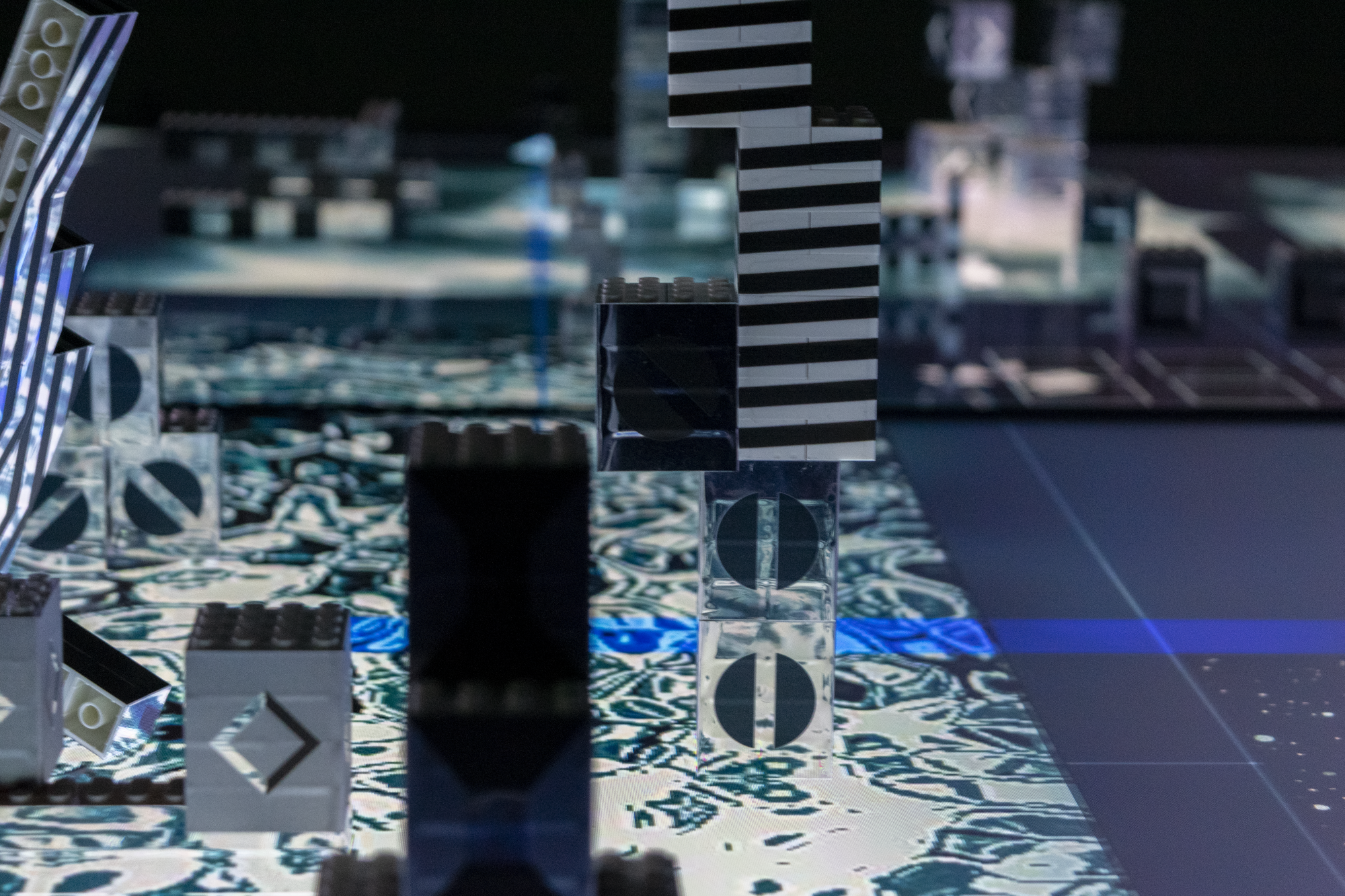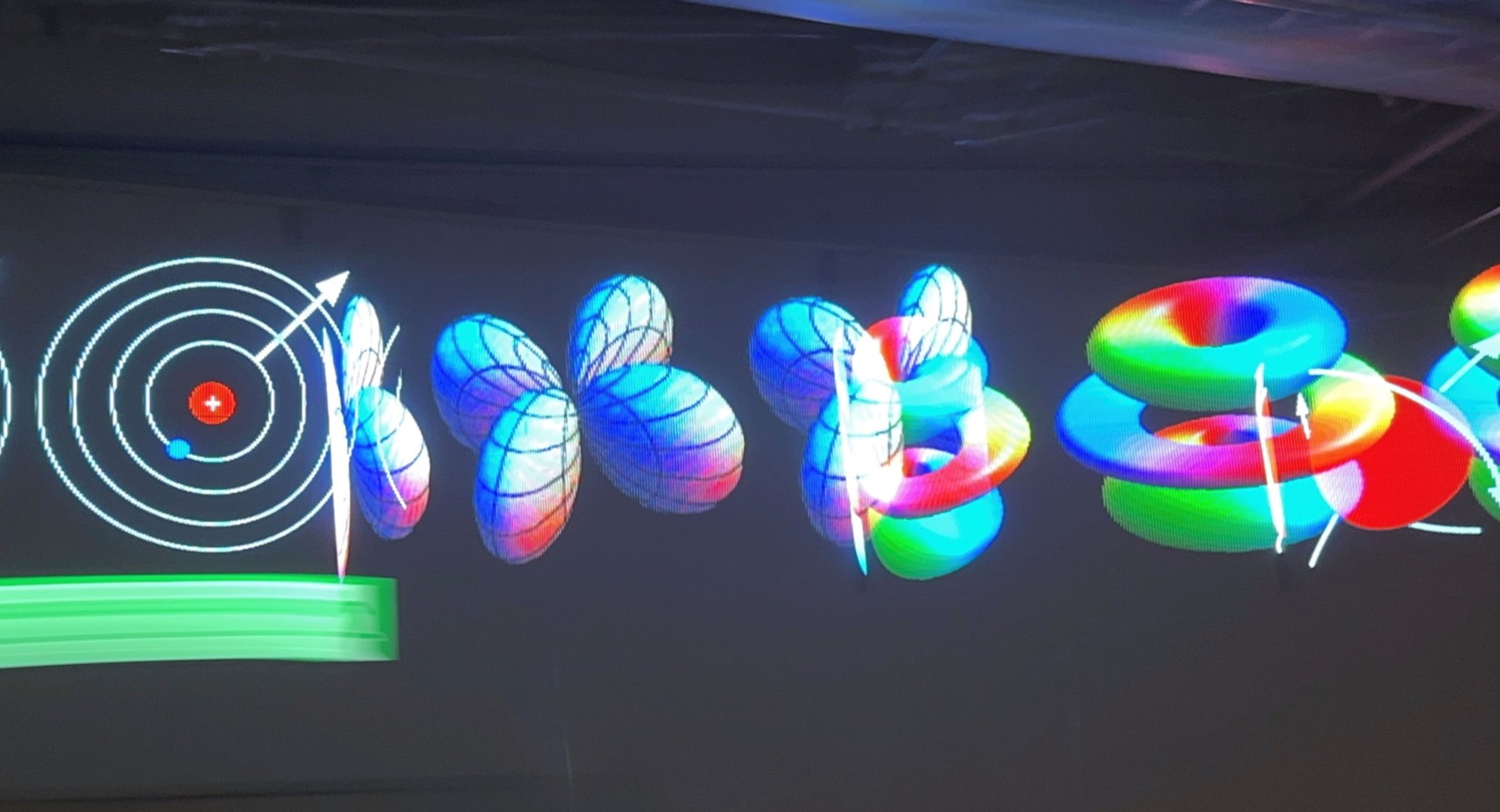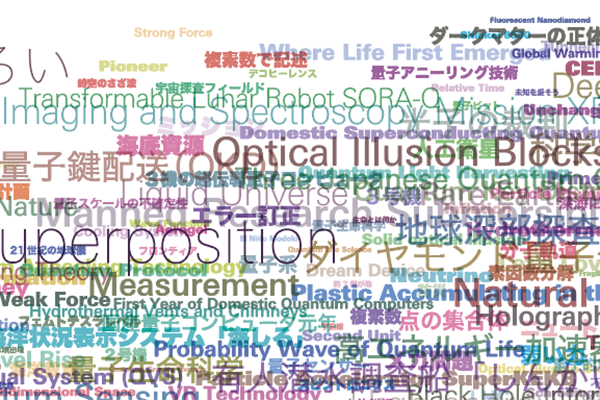HOME |EXHIBITION |STAGE | REPORT
Prologue

Prologue/Before heading into the exhibition
First of all, take a look at the A city composed of optical illusions, a map of this entire venue, made from “optical illusion blocks.” Walk around the venue while thinking about our uncertain “vision,” which fluctuates with changes in light and viewing angle. Then, these “optical illusion blocks” will make another appearance at the very end of this exhibition.
Next, we will introduce the “attempts by pioneers " which continue to today. Mainly by books and reference materials, we will trace the footsteps of four physicists who built the foundations of quantum mechanics in Japan, and artists who were among the first to respond to the new worldviews brought by science and technology, and created innovative art expressions.
Furthermore, experience the artwork using a “saccade display,” thinking about what we see and what is seen, and also the effects they have on our inner selves and our bodies. Then, let us dive into the exhibition space, while looking at the large-scale graphics with countless keywords which are scattered throughout the space, and “hints” panel about the exhibition.
ART
Main Visual : Q-Ring
Yasuhito Nagahara
2025

Q-Ring takes inspiration from the photon, the smallest unit of light and one of the basic particles in quantum physics. The work is composed of five closed lines representing the elements through which we perceive light: the three primary colors of light—red, green, and blue violet (RGB)—along with brightness and darkness. These lines loop and intertwine to form a ring, evoking a cosmos that flows continuously from the minuscule to the immense, while glimmers of colored light spill out around the edges. In keeping with the fundamental quantum principle of indeterminacy, the form is designed to shift slightly each time it is rendered.
ART
A City Composed of Optical Illusions |Incidental Landmarks Entangled in Light and Perception
Optical Illusion Block Project
Tomoko Ohtani + Kazushi Maruya + Yuko Higaki + Sayumi Higo + Mieko Nakamura + Yuko Isogaya
2025

A group of researchers from diverse fields—psychology, aesthetics, and information engineering—together with designers, have created a work in which visitors can experience visual fluctuations through “optical illusion blocks” bearing a range of geometrical patterns applied to mirror-finished surfaces. Monitors embedded in the tabletops successively display video footage of the venue alongside abstract visual compositions inspired by each installation. Three-dimensional clusters of these blocks, placed atop the screens, appear to shift in form and gently sway—depending on the ambient light from the video, the viewer’s angle, and even their internal state of mind.
Our visual perception is full of subtle fluctuations that often go unnoticed. As you move through the exhibition, we invite you to become attuned to how your own perception may shift in response to these quiet visual tremors.
Cooperation:Nakagawa Chemical Co., Ltd. Art Media Center, Tokyo University of the Arts Department of Arts and Sciences, Faculty of Fine Arts, Osaka University of Art, Communication Science Laboratories, NTT, inc, National Institutes for Quantum Science and Technology (QST)
Reference material,
Documents/books|Pioneers of science/art 1
In Japan, from before World War II to after, during the period of rapid economic growth and the Osaka Expo’70, pioneers in both science and art undertook brilliant endeavors that laid the foundations for the present. In the field of science, among the scientists who studied at the RIKEN Institute under Yoshio Nishina, the “father of Japanese modern physics,” Hideki Yukawa and Shinichiro Tomonaga are known for their meson theory and renormalization theory, respectively, while Leo Esaki discovered the tunneling effect in semiconductors and developed the Esaki diode.
The latter three won Nobel Prizes in the 20th century and made significant contributions to the development of quantum mechanics around the world.
Documents/books|Pioneers of science/art 2
From the 1960s to around 1970, art created using “classical” computers showed great popularity both in Japan and overseas. We introduce works from the “dawn of computer art” period, including Hiroshi Kawano, known for his “Computer and Aesthetics,” and works/materials by the Computer Technique Group (CTG) and its member Masao Komura, known as “electronic hippies” and invited to the “Cybernetic Serendipity” exhibition (ICA, London), as well as reference books by the artists who were interested in quantum studies in 1990s / 2000s.
ART
Superposition, Entanglement, Measurement - Saccade-Based Display
Hideyuki Ando
2025

This innovative display system projects images in midair from a single column of LEDs by utilizing “saccades,” or rapid-eye movements. Try shaking your head or moving your eyes around to experience this phenomenon in which images appear to overlap and intertwine in space.
Cooperation:Shigenori Tanaka (Kobe University), National Institutes for Quantum Science and Technology (QST)
ART
The Art of Entanglement
Yasuhito Nagahara
2025

At the end of the prologue, a 6.6-meter-wide wall displays layers of keywords regarding to the exhibition. Each word has different size and color, their arrangements are determined by chance.
Just as gas and cosmic dust scattered throughout space form nebulae, and as raindrops that fall from clouds to the ground return to the sky to form clouds again, those many words hide behind in the background of this exhibition are entangled here.
